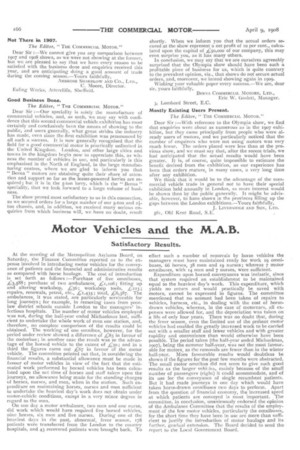Motor Vehicles and the M.A.B.
Page 18

If you've noticed an error in this article please click here to report it so we can fix it.
Satisfactory Results.
At the meeting of the Metropolitan Asylums Board, on Saturday, the Finance Committee reported as to the expense involved in introducing motor vehicles for the conveyance of patients and the financial and administrative results as compared with horse haulage. The cost of introduction is set forth as follows ;—Purchase of five omnibuses, £3,588; purchase of two ambulances, £1,1o6 ; fitting up and altering workshop, £36; workshop tools, £223; repairs, renewals, petrol, etc., £1,434; total, £6,387. The ambulances, it was stated, are particularly serviceable for long journeys ; for example, in removing cases from poorlaw district schools outside London to the managers' infectious hospitals. The number of motor vehicles employed was not, during the half-year ended Michaelmas last, sufficient to undertake the whole work of even one station, and, therefore, no complete comparison of the results could be obtained. The working of one omnibus, however, for the period under review showed a difference of £83 in favour of the motorbus; in another case the result was to the advantage of the horsed vehicle to the extent of £30; and in a third the figures came out £67 in favour of the motor vehicle. The committee pointed out that, in considering the financial results, a substantial allowance must be made in favour of motor vehicles in view of the fact that the estimated work performed by horsed vehicles has been calculated upon the net time of horses and staff taken upon the journeys, no allowance being made for the standing charges of horses, nurses, and men, when in the station. Such expenditure on maintaining horses, nurses and men sufficient to undertake the heaviest day's work does not obtain under motor-vehicle conditions, except in a very minor degree in regard to the men.
On one day a motor ambulance, two men and one nurse, did work which would have required five horsed vehicles, nine horses, six men and five nurses. During one of the heaviest days in the past, abnormal, fever season, 178 patients were transferred from the London to the country hospitals, and 43 recovered patients were brought back. To effect such a number of removals by horse vehicles the managers must have maintained ready for work 19 omnibuses, 66 horses, 38 men and 19 nurses; whereas 7 motor omnibuses, with 14 men and 7 nurses; were sufficient. Expenditure upon horsed conveyances was inelastic, since that system required an establishment to be maintained equal to the heaviest day's work. This expenditure, which yields no return and would practically be saved with motors, cannot be expressed in figures. The committee mentioned that no account had been taken of repairs to vehicles, harness, etc., in dealing with the cost of horsedrawn vehicles, whereas, in the case of motorcars, all expenses were allowed for, and the depreciation was taken on a life of only four years. There was no doubt that, during the fever season, even the limited use of the present motor vehicles had enabled the greatly increased work to be carried out with a smaller staff and fewer vehicles and with greater rapidity and convenience than would otherwise have been possible. The period taken (the half-year ended Michaelmas, 1907), being the summer half-year, was not the most favourable for motors, as the removals are fewer than in the winter half-year. More favourable results would doubtless be shown if the figures for the past few months were abstracted. The small motor omnibus did not seem to give such good results as the larger vehieles, mainly because of the small number of passengers (eight) it could accommodate, and of its use for the conveyance of single recumbent patients. But it had made journeys in one day which would have taken horse-drawn omnibuses two days to perform. Apart from the question of financial economy, the increased speed at which patients are conveyed is most important. The committee, in conclusion, unanimously endorsed the opinion of the Ambulance Committee that the results of the employment of the few motor vehicles, particularly the omnibuses, for the short time they have been in use are more than sufficient to justify the introduction of motor haulage and its further, gradual extension. The Board decided to send the report to the Local Government Board.




























